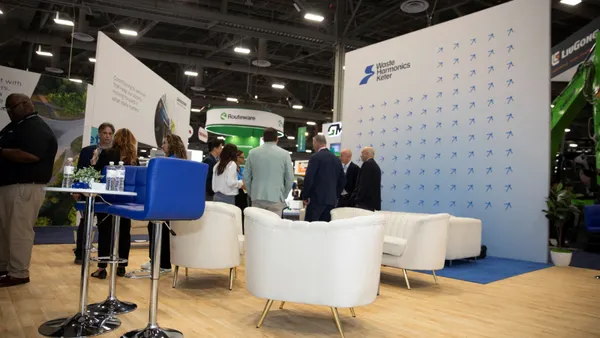Unless a new initiative is being rolled out, or something goes wrong, the role of public works and environmental departments usually goes unnoticed. Last week, officials from some of the biggest cities in the country had an event all to themselves.
The U.S. Conference of Mayors' Municipal Waste Management Association held its fall summit in Houston to share ideas and help attendees think beyond their own city limits. While everyone had the shared experience of working with elected officials, contractors and constituents brought with them a variety of different perspectives. Some have been busy preparing for and cleaning up after natural disasters. Others were more focused on expanding local end markets or stabilizing their recycling programs.
Waste Dive listened right alongside them, and you can expect further stories that germinated there to appear in the weeks ahead. In the meantime, here are three of the main topics that stood out about the one thing nobody can stop talking about — recycling.
The cost of doing business
As is the case with any industry event lately, financial factors were front and center. Most local officials were relatively quiet about how much their own costs have increased, but the industry representatives on hand weren't shy about making the case for why they felt that cost increases were in fact overdue in many cases.
- Susan Robinson, director of federal public affairs for Waste Management, made a familiar case around rethinking recycling priorities based on greenhouse gas emissions and other factors. “We need to start to help our customers understand the connection between what goes in the recycling cart and what actually gets recycled," she said.
- Richard Coupland, vice president of municipal services for Republic Services, highlighted the embedded costs of recycling service his company believes have been overlooked for too long. The fact that per household rates have been artificially low, processing costs increased "dramatically" in recent years and commodity prices are down means the industry's average gap to service one home per month may now be as high as $5.60.
- Coupland also touched on how changing material streams have complicated the equation. For example, lightweighting of water bottles means it now takes about 90,000 to equal one ton. It used to take 40,000.
- Both also noted many MRFs were built to handle newsprint, which is now a fraction of the recycling stream, and the average facility is still adapting. “We are still paying for the capital that we bought to separate newsprint in this industry," said Coupland. “They weren't build to handle clamshells, yogurt cups or deli trays," said Robinson.
Fighting contamination, pushing education
Against the backdrop of price increases, local governments are especially interested in finding ways to clean up their streams. A running theme throughout the event was the sharing of contamination rates as a form of catharsis. Many were surprised to learn their cities were facing similar challenges, or perhaps faring better than others.
The Recycling Partnership's Chris Coady encouraged local governments to emphasize the positive aspect of this conversation — people have valuable resources sitting in their kitchens or garages waiting to be turned into something new — as a way to boost engagement. “No matter how big or small your community is you have that resource to be recovered," said Coady, a senior technical assistance specialist with the nonprofit.
- El Paso, Texas, which has an average contamination rate of around 34%, shared early results from a cart-tagging pilot it conducted with assistance from The Recycling Partnership. During an initial summer pilot, about half of all carts were rejected. By the end of an eight week cycle, that amount was down to 10%. Official results will be forthcoming as the pilot continues in new neighborhoods across the city.
- Julia Greene of Lynn, Massachusetts — which conducted its own campaign with state funding — said persistence and targeted efforts were key. Greene worked with staff to send letters to owners of 294 multi-unit buildings where material had been rejected multiple times, along with a recommended lease rider based on language from New York.
- Psychology was also said to play an important role. The Recycling Partnerships "Oops/Shine On" system has become prevalent in many communities around the country, and inspired similar initiatives such as MassDEP's Recycling IQ Kit, but local touches are still being tested out. Lynn found success with a "love note" that served as in-between marker for residents that hadn't quite figured things out, whereas Coady said one Florida city tested out an "okay job" tag that had no discernible effect.
Goals, program changes and new ideas
The markets discussion featured plenty of talk about how local governments measure their progress — as just about everyone in the room was operating under some type of future diversion target — along with some questions about what success should really mean. With many cities already on the path toward big diversion rate targets, they're still looking for ways to expand their offerings in an effort to reduce the amount of material going to landfills or waste-to-energy facilities.
- Albuquerque, New Mexico has been focusing on textiles. “Now more than ever with the market change I think it’s a really good idea to examine source reduction [and] reuse," said Acting Solid Waste Director Jill Holbert. Working with a local nonprofit, the city has collected more than 11,000 pounds of clothing for homeless public school students. Plus, drop-off events offer a chance to educate residents about the city's broader recycling program.
- Seattle, which had a reputation at the event for being ahead of the curve, is turning its attention to existing problem areas and emerging opportunities. Ken Snipes, deputy director for solid waste, said this will include multi-family residential buildings, solar panels (which he called "particularly problematic for recycling") and possibly even new extended producer responsibility policies around certain types of plastic.
- Shirlene Sitton, director of Santa Fe, New Mexico's Environmental Services Division, said the city pulled in an estimated $200,000 last year from paper bags fees that has been very helpful for education and outreach efforts.
Correction: A previous version of this article referred to the cost figure in Republic's presentation as $5.60 per ton.









